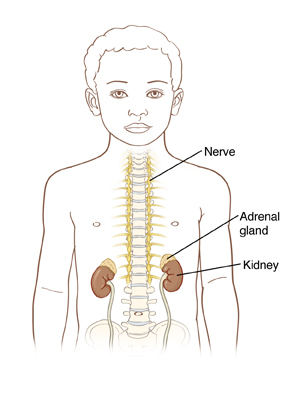
Neuroblastoma may be found in the adrenal glands and paraspinal nerve tissue from the neck to the pelvis.
Neuroblastoma is a solid cancer of the nerve tissue of the sympathetic nervous system. It often begins in the adrenal glands, which are small glands on top of each kidney. It can also begin in the chest, in nerve tissue near the spine in the neck, or in the spinal cord.
Neuroblastoma usually begins in early childhood, with about two thirds of the cases presenting before the age of 5. It can be present at birth, but is most often diagnosed much later when the child begins to show symptoms of the disease. In the majority of cases, neuroblastoma has already spread to areas outside of the original site at the time of diagnosis.
A condition known as “opsoclonus-myoclonus syndrome” can sometimes be a symptom of neuroblastoma. It is bursts of rapid and involuntary, chaotic eye movement in all directions. It is important to note that not all children with this syndrome have neuroblastoma.
The diagnosis of neuroblastoma requires the involvement of pathologists who are familiar with childhood tumors, since both the symptoms of the cancer and the cancer cells themselves are similar to those of other childhood cancers.
- More information on neuroblastoma on the NCI web site – note that you can toggle back and forth between “Health Professional” and “Patient” versions.
Treatment
Neuroblastoma is divided into low-, intermediate-, and high-risk groups according to how far the disease has spread. Results of the following procedures determine the neuroblastoma risk group:
- Bone marrow aspirates and biopsies determine if the bone marrow is involved.
- Bone itself is assessed by metaiodobenzylguanidine (MIBG) scan (and by technetium 99 scan if the results of the MIBG scan are negative).
- Lymph nodes are examined.
- The abdomen and liver are assessed by CT scan and/or MRI; the chest should be examined by CT.
The stage of the disease is determined according to the International Neuroblastoma Staging System. Details of this staging system are given on the following NCI web page:
Treatment for low-risk patients can be either “watch and wait” to see if the tumor disappears on its own, surgery alone, or surgery and a few months of chemotherapy (carboplatin, cyclophosphamide, doxorubicin, and etoposide). Intermediate-risk patients receive surgery and 12-24 weeks of the same chemotherapy.
Treatment for high-risk neuroblastoma includes aggressive multi-agent chemotherapy consisting of very high doses of the drugs listed above and usually also ifosfamide and high-dose cisplatin. After the patient has shown some response to this chemotherapy, the tumor is removed by surgery, followed by myeloablative chemotherapy, radiation of the tumor/metastases site, possible total-body irradiation, and autologous stem cell transplant. After recovery, patients are treated with oral 13-cis-retinoic acid for 6 months.
Clinical trials for neuroblastoma and for soft tissue sarcomas can be found by searching the clinical trial database on the NCI web site. Follow these directions:
- Start at the NCI clinical trials search page.
- Choose type of cancer: “neuroblastoma. “
- You will be given more choices (e.g., type of cancer and type of trial). Choose the appropriate responses and click “search.”
Symptoms of Neuroblastoma
The symptoms of neuroblastoma are caused by the tumor pressing on nearby tissues as it grows. Its symptoms mimic many other diseases and its diagnosis can be complicated. Even a pathological study (biopsy) might reveal cells that can resemble other small round blue tumor cells, like lymphomas and rhabdomyosarcomas. Only a pathologist familiar with neuroblastoma can distinguish the difference (neuroblastoma is rare, and not every pathologist has seen these cells).
Symptoms can include:
- lump or mass in the abdomen, neck, chest, or pelvis
- loss of appetite, nausea, weight loss, stomach pain, constipation, diarrhea, difficulty urinating
- changes in the eyes: black eyes, a droopy eyelid, a pupil that doesn’t constrict, vision problems
- pain in the chest, difficulty breathing, persistent cough
- in infants, painless, bluish lumps under the skin
- bone pain, fever, irritability, listlessness
- backaches
- pain or numbness in the lower extremities, limping, inability to stand, stumbling
Statistics, Risk Factors, Incidence
- Approximately 500-1000 cases/year in the US .
- 8% of all cancers, but responsible for over 15% of deaths.
- Median age at diagnosis is 2 years old.
- In 70% of the cases the disease has spread to other parts of the body at diagnosis.
- The prognosis for high-risk neuroblastoma was 20% until recently. Encouraging developments are increasing the chances of survival.
Resources
Websites
- MD Anderson Cancer Center Children’s Cancer Hospital– MD Anderson’s website contains information on the symptoms, diagnosis, and treatment of childhood cancers. You can also find information about their Childhood Cancer Survivors Clinic, clinical trials, etc.
- Neuroblastoma Children’s Cancer Society: Excellent resource and links
- ped-onc resource center
E-mail Support Lists
ACOR: N-blastoma
More about Childhood Neuroblastoma Cancers:
- About Childhood Neuroblastoma Cancer – Detection and Diagnosis
- Causes, Risk Factors, and Prevention of Childhood Neuroblastoma Cancer
- What are the signs and symptoms of Childhood Neuroblastoma Cancer?
- Childhood Neuroblastoma Cancer Treatment
- Childhood Neuroblastoma Cancer – Stages and Prognosis
- What is the expected life span of Childhood Neuroblastoma Cancer?
- After Treatment – Living as a Childhood Neuroblastoma Cancer Survivor
Learn More About the Different Types of Childhood Cancers:
- Childhood Brain Tumor Cancer (Brain Stem Tumors)
- Spinal Cord Tumor Cancer
- Childhood Neuroblastoma Cancers
- Childhood Hodgkin Lymphoma Cancers
- Non-Hodgkin Lymphoma Cancers
- Wilms tumor (Kidney Tumors)
- Rhabdomyosarcoma
- Retinoblastoma
- Bone cancer (including osteosarcoma and Ewing sarcoma)
- Leukemia Cancers: Acute lymphocytic (lymphoblastic) leukemia (ALL) Acute myelogenous leukemia (AML); Juvenile myelomonocytic leukemia (JMML)
- Hepatoblastoma (Liver Cancer)
- Rhabdoid Tumors
For more information about the American Childhood Cancer Organization call 855.858.2226 or visit:


